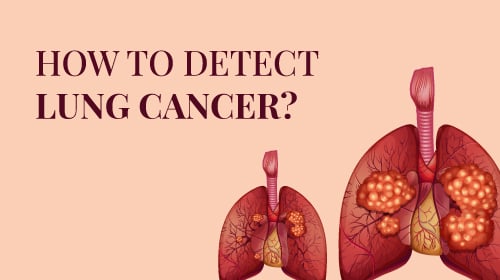Lung Cancer: Symptoms, Risk Factors, Stages & Diagnosis
March 18, 2025

The abnormal growth of cells causes lung cancer. This is because the cells grow into a mass or tumor. Any abnormal increase in the body invades surrounding tissues and organs, spreads to other parts of the body, or has the potential to grow back after removal is called “malignant” or cancerous.
Who is at Risk for Lung Cancer?
Lung cancer can take several years to develop, although the sooner it is detected and treated, the better the chance of a successful outcome. Cigarette smoking is one of the most common risk factors for developing lung cancer. Many people exposed to cigarette smoke or some of its components will have permanent lung changes. These changes can lead to the development of a cancerous tumor within the lung. About 25% of all lung cancer cases occur in people who have never smoked. The underlying cause is not understood in these cases. Two out of three people diagnosed with lung cancer are over 65.
Stages of Lung Cancer
Staging allows the doctor to fully understand the extent of the patient’s cancer to make treatment decisions and predict expected outcomes.
The TNM System
The TNM system is a way to classify diseases by their symptoms.
- T – Your lung cancer stage is based on how big the tumor is and where it is located in your lungs or body.
- N – indicates the number of times a node is involved in a certain path. For example, this test determines whether or not your cancer has spread to your lymph nodes near your lungs.
- M – stands for metastasis. This means whether or not your cancer has spread.
Lung cancer can spread to your other lungs, liver, bones, brain, kidneys, adrenal glands, or other body parts.
Your doctor can identify your tumor’s stage by listing the letters and numbers 0-4. Your tumor will be measured in centimeters and assigned a number, the larger the number, the more it has grown or spread. They could also use X as a number. This means the tumor cannot be measured, or it is unclear how far it has spread. When your doctor says your lung cancer is “unresectable,” surgeons can’t remove it.
Small-Cell Lung Cancer Stage
If you have this type of cancer, your doctor may use the TNM system to classify it. They will assign your cancer a stage according to its severity.
If you have this type of cancer, your doctor may use the TNM system to classify your cancer. They will then place your cancer in one of two main stages:
- Limited stage: It’s in just one lung and possibly near the lymph nodes. It has not spread to all lungs or bypassed your lungs.
- Extensive Stage: Your tumor has spread to other parts of your lungs and chest. It may have spread to the fluid around your lungs (the pleura) or other organs.
Non-Small-Cell Lung Cancer
Non-small-cell lung cancer is more common than small-cell lung cancer. Its clinical stage can classify NSCLC. Doctors may use image scans to take pictures of the body to confirm the clinical stage of cancer. A small piece of tissue may be taken from the tumor and biopsied to confirm the diagnosis.
If you have cancer surgery, your doctor can look at your tumor and find out the pathological stage of your cancer. This report tells your doctor how far the cancer has spread or grown.
The most common way to stage NSCLC is using the TNM system, with the numbers X, 0, 1, 2, 3, or 4 after each letter.
Number and letter combinations include
- The width of your tumor, measured in centimeters, or if it’s too small even to measure
- Where your tumor is in your lungs
- When there is more than one tumor in the same lung
- If your airways are partially blocked or so congested that a collapsed lung or pneumonia may occur
- If the tumor has spread to your lymph nodes or other organs
Doctors may use general stages to classify NSCLC. For example, your doctor may use the TNM system and numbers to determine the stage of cancer in each of the following cases:
- Occult Stage: Cancer cells can be found in the mucus you cough up. No tumor can be seen by image scan or biopsy. It’s also known as hidden cancer.
- Stage 0: The tumour is microscopic. The cancer cells haven’t spread to other parts of your body or other people.
- Stage 1: The cancer is located in your lung tissue but is not present in your lymph nodes.
- Stage 2: The disease may spread to the lymph nodes near your lungs.
- Stage 3: There is a possibility that the disease has spread to your lymph nodes near your lungs.
- Stage 4: Cancer has spread throughout your body. It could have spread to your brain, bones, or liver.
Causes
Lung cancer occurs when lung cells undergo abnormal changes, leading to uncontrolled growth. Key causes include:
- Smoking and Tobacco Use: The primary cause of tobacco smoke is carcinogens that damage lung cells and trigger cancer.
- Radon Gas Exposure: Inhaling this radioactive gas from soil and rocks can increase lung cancer risk.
- Air Pollution and Toxins: Long-term exposure to polluted air, asbestos, or industrial chemicals can lead to lung cancer.
- Genetic Mutations: Inherited genetic changes can raise the risk, even in non-smokers.
- Chronic Lung Inflammation: Conditions like COPD or tuberculosis can cause lung tissue damage, increasing cancer risk.
- Unknown Causes: Some cases occur without clear risk factors, possibly due to spontaneous genetic mutations.
Symptoms
Lung cancer usually has no symptoms in its early stages. However, if the cancer is symptomatic, it may cause shortness of breath, coughing, or chest pain. When signs of illness begin to appear, they may include:
- Chronic hacking, raspy cough, sometimes with bloody phlegm
- Changes in a cough that you have had for a long time
- Respiratory infections that keep coming back, including bronchitis or pneumonia
- Shortness of breath that gets worse
- Wheezing
- Persistent chest pain
- Hoarseness
- Swelling of the neck and face
- Pain and weakness in your shoulder, arm, or hand
- Fatigue, Weakness, weight loss, and appetite, fever that comes and goes
- Severe headache and body aches
- Difficulties swallowing
Risk Factors for Lung Cancer
Various factors, such as lifestyle habits, environmental conditions, and genetic susceptibility, can raise the risk of lung cancer.
Smoking
Cigarette smoking is the most crucial risk factor for developing lung cancer. The use of other tobacco products, such as cigars or pipes, also increases the risk of lung cancer. Tobacco smoke is a mixture of more than 7000 different chemicals. Many things can be poisonous. Smoking cigarettes is a leading cause of lung cancer and death. People who do not smoke are 15 to 30 times more likely to avoid this fate. Even smoking a few cigarettes a day occasionally increases the risk of lung cancer.
Smoking cigarettes is a leading cause of lung cancer and death. People who do not smoke are 15 to 30 times more likely to avoid this fate. Even smoking a few cigarettes a day occasionally increases the risk of lung cancer. The more years a person smokes and the more cigarettes they smoke each day, the greater their risk of developing a smoking-related disease.
Second-hand Smoke
Secondhand smoke from other people’s cigarettes, pipes, or cigars can cause lung cancer. When a person inhales indirect smoking, Seems that they are smoking.
Family history of lung cancer
A person’s family history may increase lung cancer risk; this risk increases with exposure to other risks, such as smoking. You are twice as likely to have cancer if a family member has lung cancer than if there is no history of the disease in your family.
Diagnosis
A doctor usually diagnoses lung cancer by examining the patient’s symptoms and medical history. A biopsy may also determine the cancer’s stage and how far it has spread. Your doctor may suspect lung cancer if the physical exam shows:
- swollen lymph nodes above the collarbone
- abdominal mass
- weak breathing
- Abnormal lung sounds
- sluggishness when patted on the chest
- unequal students
- sagging eyelids
- Weakness in one arm
- Dilated veins in the arms, chest, or neck
- Swollen face
If lung cancer is causing symptoms, it is usually visible on an X-ray. On a chest X-ray taken for another cause, lung cancer that has not yet shown signs may occasionally be visible.
Your doctor might advise a chest CT scan if they feel that a more detailed exam is necessary. For example, a lung cancer diagnosis is usually confirmed with a lung biopsy. The doctor guides a thin, lighted tube through your nose or mouth and into the air passages to the tumor. They then remove a tiny tissue sample. This is a bronchoscopy with a biopsy performed using endobronchial ultrasound (EBUS) guidance. This is useful for tumors near the center of the lung.
Treatment
There are several types of treatment for lung cancer, depending on the type of cancer and how far it has spread. For example, some people with non-small cell lung cancer can be treated with surgery, chemotherapy, radiation therapy, targeted therapy, or a combination of these treatments.
- Surgery is a medical procedure that is used to treat a variety of illnesses and injuries. A process in which doctors cut out cancerous tissue.
- Chemotherapy is a type of cancer treatment. Cancer can be treated with certain medicines that will shrink or kill it. Medications can be pills you take, medications in your veins, or sometimes both.
- Targeted therapy approaches treat a disease or condition that focuses on specific body areas. For example, cancer cells can grow and spread if not stopped. Drugs can help block the growth and spread of cancer cells. These drugs may be taken in pill form or intravenously as an anesthetic. You will first be given tests to see if targeted therapy suits your cancer type. If it is, this treatment will be used.
Frequently Asked Questions
1. What does early-stage lung cancer feel like?
In the early stages, lung cancer usually has no visible or felt symptoms. Later, it often causes coughing, wheezing, and chest pain.
2. How can I check myself for lung cancer?
The only recommended screening test for lung cancer is a low-dose computed tomography scan (LDCT). During an LDCT scan, you lie on a table, and an X-ray machine uses a low dose of radiation to make detailed images of your lungs. The scan will only take a few minutes and is not painful.
3. Where does lung cancer usually start?
Cancers of the lung usually start in cells that line the bronchi and parts of the lung, such as the bronchioles or alveoli.
4. What is the life expectancy for someone with lung cancer?
Over the last ten years, the median survival for lung cancer has risen from 11 months to a 5-year survival rate of 17.8%. This advantage is primarily due to the availability of targeted therapy medications and the proper patient selection. In other words, precision oncology and customised medicine. To a considerable extent, this is only achievable because of molecular oncology.
5. Can lung cancer be cured permanently?
Remission success is dependent on how early the condition is detected and what other health issues you may be dealing with. And there is always a possibility (often a very small one) that lung cancer will resurface even after years or decades of remission.







